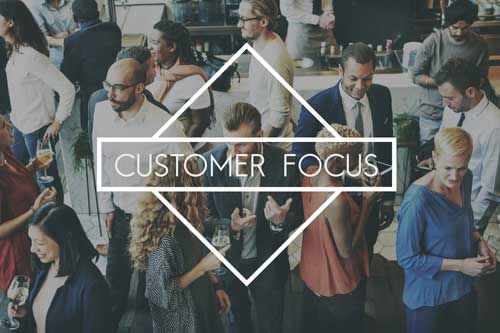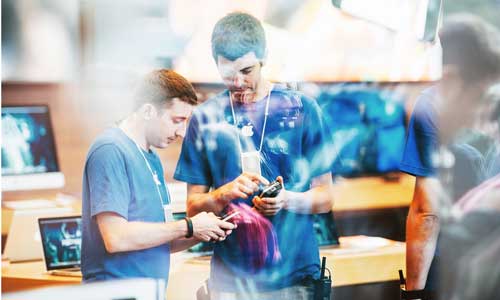In the quest to improve customer experience and loyalty, it’s helpful to consider the ‘cultural habits’ of successful service organizations such as: Disney, Apple, Southwest Airlines, Wegmans, Nordstrom, and Amazon. Their cultural habits are not merely lip service; it’s how they do business.

Cultural Habit #1: Delivering a great customer experience is a way of doing business – it’s not just a program.
Amazon’s vision statement says: “We seek to be Earth’s most customer-centric company for four primary customer sets: consumers, sellers, enterprises, and content creators.” Amazon puts a stake in the ground by announcing its hope to be the world’s most customer-centered company.
Wegmans’ motto is: “Every day, you get our best.” Wegmans makes grocery shopping a true experience rather than offering the same drudgery of a chore that most consumers expect at the grocery store. Its reputation goes well beyond its market area. Wegmans has reported that it received nearly 5,000 letters and e-mails in a year from consumers in 46 states who urged the chain to open a store in their area. Now Wegman’s is applying the same customer focused strategy to it’s on-demand food delivery service, meals2GO.
Southwest Airlines began at Love Field in Dallas. They became the “love airline” with the flashy flight attendants and the most entertaining flight experience. The President Emeritus, Colleen Barrett, has a favorite saying about Southwest Airlines: “We are a Customer Service Company; we just happen to fly airplanes.”
Apple’s sales per square foot are higher than Tiffany and Co.’s. Employees are supposed to focus on helping customers, not selling products. A quote from the training manual demonstrates this commitment: “Your job is to understand all of your customers’ needs—some of which they may not even realize they have.”
Disney cast members are taught an important truth: “The guest isn’t always right, but let them be wrong with dignity.” A secret to Disney’s success is their guest-centered approach. Their philosophy is not just lip service – it actually guides behavior. Disney cast members consider what they do to be a helping profession and a noble calling.
Companies who lead in customer service don’t legislate it with policies and procedures – they live it. Employees routinely go the extra mile and the stories that are shared within the companies become the standards to live by, deliver and surpass. Are they perfect? No, but employees want to do well because the leaders lead the way. Other companies have programs that are “flavor of the month,” changing without reason or inspiration.
Cultural Habit #2: Employee satisfaction and loyalty leads to customer satisfaction and loyalty.
Nordstrom’s golden rule for employees is widely recognized: “Use good judgment in all situations.” Top service companies are willing to trust employees.
Amazon’s approach is to hire the world’s brightest minds and to create an environment where they can invent and innovate the customer experience.
Gary Kelly, President of Southwest, was asked, “What is the secret of Southwest’s success?” He answered with a simple statement, “Our secret weapon is our people.” Southwest puts all prospective employees through a rigorous hiring process. New employees learn nine loyalty principles, some of which include: find the kid in everyone, do more with less, do what is right, and nurture the corporate family. At Southwest, employees are at the top of the priority pyramid; for this reason, Southwest focuses on delivering employees proactive customer service. Southwest believes that by doing this, employees will, in turn, spend their time trying to ensure the passengers, the second most important group of the pyramid, are getting great customer service, too.
Employees at Disney are “cast members,” not employees. People are never hired; they’re “cast for a role.” A strong Disney principle is that cast members should treat each other as they would a guest. The Disney formula for success is: “A quality guest experience + a quality cast experience + quality business practices = the future.”
Apple’s Genius Bar employees are trained to say, “As it turns out” instead of “unfortunately,” in order to place a more positive spin on any bad news. If a customer mispronounces a product name or something else, employees are taught how to help without correcting the customer.
Instead of starting with the customer, these organizations start by investing and empowering employees. While other companies claim customer service is their top priority, their actions too often illustrate that shareholders, and short-term performance really takes precedence. Inevitably, their quality and service suffers because their goals and behavior aren’t aligned; yet, they still don’t seem to understand why they are faltering.

Cultural Habit #3: Ongoing learning and development are integrated into the fabric of the organization.
Wegmans has an extensive employee-training program, and it’s consistently listed as one of Fortune’s Magazine’s most admired companies. Colleen Wegman, the President, says, “The reason we have grown slowly is that we want to make sure our people are fully prepared and trained to deliver our model of incredible service.”
Apple’s meticulous attention to detail permeates the hiring process. Prospective employees generally participate in several rounds of competitive interviews, which assess various skills and attitudes. Once hired, employees are trained extensively in customer service, sales and product knowledge.
Walt Disney established the Disney University after opening Disneyland to use a structured learning environment to teach the unique skills that are required of Disney cast members. It was the first corporate university and remains one of the largest training facilities in the world. Numerous classes and dozens of online courses provide a plethora of learning opportunities to employees and managers alike. Surprisingly, Disney University does not offer specific quality courses. Quality and service are built into all the training programs taught by Disney. In addition, Disney courses have been delivered to hundreds of other companies.
Tom Peters once said that in the best organizations, “Everyone has a chance to learn, improve and build up their skills.” That is true in customer focused companies and not in others.
Cultural Habit #4: The customer experience is researched and measured, and then the data is applied.
On the desk of Pete Nordstrom, the company’s President of Merchandising, sits a stack of letters from customers and employees, each telling a story about a memorable experience they had with Nordstrom. Few company executives can say the same.
For years, Wegmans has used customer relationship management tools to gain insight into the customers’ wants, needs, and behaviors, so that employees can deliver better service.
Apple doesn’t have strict sales quotas in place for employees. It does have metrics like “attachment rates,” the frequency with which staff members are able to provide customers with additional products like AppleCare. Those who fall short of the goals receive more sales training, which is really about helping customers with stated or perceived needs.
Compare the above strategies to a retailer who spends a few million dollars each year on customer surveys and mystery shops, but has failed to improve. Customer focused companies measure service and sales, sometimes in unusual ways, and then share it so it is relentlessly applied to achieve better results.
Cultural Habit #5: Continuous improvement is expected, and the speed of gain is second to none.
The culture of Amazon promotes openness among all employees, which they believe inspires innovation. Their executive management supports this principle, which sets the example that employees then follow. Through this process, Amazon patented the one-click ordering technology, allowing customers to use previous payment information with a simple click. This makes shopping easier because less thought and effort are needed. Jeff Bezos at Amazon also developed the notion of the “two-pizza team,” which suggests that you can’t feed one team with two pizzas because that’s too much food. In business application, this limits the task force to 5-7 people, depending on each person’s appetite. This keeps the focus on innovating and executing the things that matter to customers.
Disney’s strong belief in “attention to detail” is what sets them apart from other organizations. Disney says it has to “sweat the small stuff.” Disney pioneered the concept of exceeding people’s expectations.
Apple’s Genius Bar is the in-store tech support station. It’s not a help desk or customer service center. The idea illustrates out-of-the-box thinking by recognizing employee potential and customer priority.
Each of the above companies have cultures that ensure they have a sense of urgency to innovate and improve, so that they continue building customer loyalty. Because employees have freedom to act, they are able to deliver creative solutions at pivotal moments for each customer, which enhances each company’s reputation and service delivery capability.
Many companies desire to deliver better service. Some try and a few improve. But, most are unwilling to make the necessary changes because they lack the commitment and more importantly, the ethics. Most say they want a superior service reputation, but they are unwilling to do the work it takes to earn it. However, any company that consistently strives to improve by aligning with these five cultural habits will make a huge difference with their employees, customers and bottom-line.
About the Author
Rick Conlow is CEO & Senior Partner of WCW Partners, a performance improvement company. Based in Minneapolis/ST. Paul, Minnesota, WCW works with clients in a variety of industries worldwide to help them excel in sales, service and leadership, facilitating business growth and vitality. Rick is author of Excellence in Management, Excellence in Supervision and Returning to Learning.




